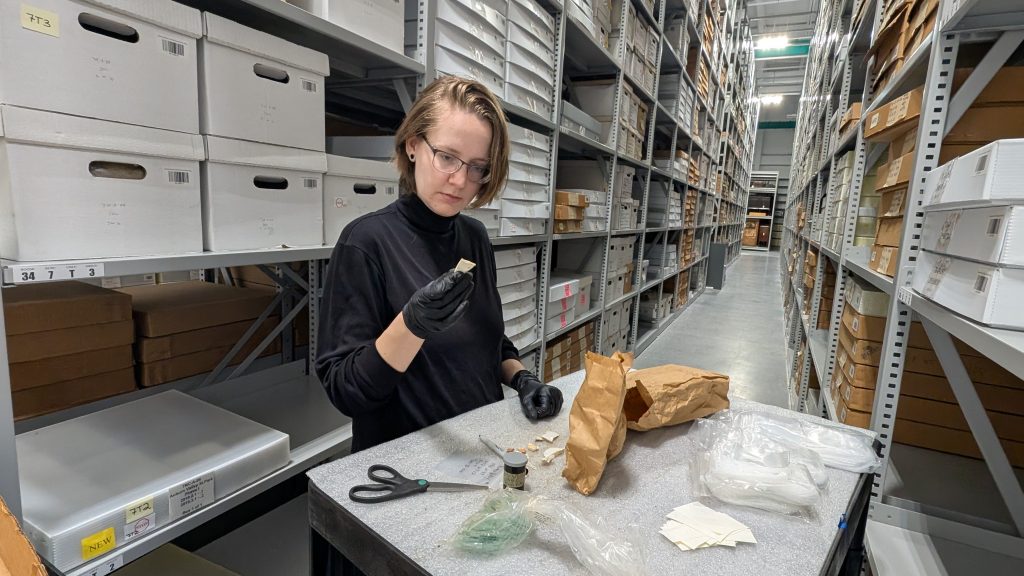New curatorial assistant reflects on the importance of archaeology
When you think of archaeology, what is the first thing that comes to mind? Maybe it’s an image of someone pulling ancient relics out of the ground with a trowel, obviously donning a broad-brimmed hat.
For many, this image of excavation is quintessential to archaeology. But that’s just one piece of the important work being done. What happens to all of those historic artifacts once they’re out of the ground — figuring out how to properly care for them, research them and display them — is just as important as finding them in the first place.
The Division of Historical and Cultural Affairs (HCA) in April 2025 welcomed Natalie Yeagley as its new curatorial assistant for archaeology, who recently shared some interesting insight on her role in the field of archaeology.
Yeagley has already been working on research for a new exhibit going in the visitor’s center at John Dickinson Plantation and assisting with important work related to the Native American Graves Protection and Repatriation Act. HCA recently connected with Yeagley to learn more about her, her work and what she hopes to explore in Delaware’s own storied history:

Can you tell us a little bit about your background?
For my bachelor’s degree (at Hood College), I double majored in history and archaeology, with a minor in classical studies. I enjoyed all parts of my studies, but especially enjoyed archaeology for its focus on all the very tangible connections to past cultures and people. I loved the fieldwork and the excavation opportunities locally and abroad. Most importantly, I loved the challenge of uncovering truths about the cultures and practices of various groups who lived and thrived in areas from which little to no written record survived.
After graduating, I spent a year employed by a local museum, where I quickly learned some of the challenges of maintaining museum collections. I went on to pursue a master’s in anthropology, focusing on archaeology at the University of Tennessee, Knoxville, before joining the team at HCA.
How did you get interested in archaeology and/or the museum field?
I have always been that kid who dug in the dirt, collecting any rock I suspected of being an “artifact” and carefully depositing it into one of the 20-plus sandwich baggies I had lined neatly along the back porch (as my lovely and supportive mother drew the line at permitting my “artifacts” to be brought inside the house). It was also thanks to my mom, whose brief experience living in Italy in her youth had inspired her to allow (and contribute towards) my own trip to Italy in high school. On that trip, my first out of the country, I discovered a love for archaeology that has since been the single biggest driving force behind my academic and career pursuits.
What have you enjoyed about working with HCA so far?
While I have enjoyed almost every aspect of working for HCA, I think my absolute favorite thing so far has been the diversity of work that we do. One day, I find myself assisting with the packaging, transport and hanging of art pieces for the governor’s office, and the next day I pack my trowel, hat and sunscreen in preparation for a full day of fieldwork. I feel in the short time I have been with HCA I have been exposed to so many new and exciting aspects of archaeology, museum studies and curation. In all my months working at HCA, I can say that no two days have been the same.
What have been your favorite projects that you’ve worked on and why?
My favorite project is my current one. In anticipation of the John Dickison Plantation’s visitor center being opened, I have been working with Karli Palmer, HCA’s Curator of Archaeology, and in consultation with members of the federally recognized Indigenous tribal nations of Delaware to provide accurate and insightful information about Delaware’s first inhabitants for an educational exhibit. We have worked together to create a map of places and features within Delaware, which have retained elements of their original names in the languages of Delaware’s Indigenous groups. As an extension of this project, I am researching ways to recreate the process of making a raised bed platform, like the ones housed within the wigwams built by the Lenape and the area’s original inhabitants. To me, this project gets at the very heart of what archaeology is all about: to not only reconnect, in a very direct way, to the people of Delaware’s past through this attempted recreation, but to also learn about these people and their practices directly through their living descendants today is such an immense honor and privilege.
How has working for HCA changed your perspective on the field of archaeology or museums?
My perspective has changed quite dramatically. I believed myself ready for this type of work, given my previous museum experience and academic training, but quickly found how wrong I was. It turns out, archaeology in academia is quite different from what it is in practice! I loved my education, had incredible mentors and great hands-on experience, but there is nothing quite like coming face-to-face with theories and laws I had only previously read about in textbooks. There are real-world challenges to the work we do that certainly were not included in the textbook scenarios. While in school, I did not see a career for myself outside of academia. Now, I could easily see myself doing this type of work for the rest of my life.
Is there anything that has surprised you during your time working with HCA?
I was pleasantly surprised by how collaborative things tend to be. I have yet to meet an HCA employee who was not busy managing various tasks within their role, but I love seeing all the ways we check in with each other, and how each employee is willing to set aside their own work if someone needs a hand (sometimes physically, even — I certainly was not expecting to help hang art at the Delaware Governor’s office when I accepted a position as a curatorial assistant of archaeology!). I have been surprised and impressed by how far and how often our work takes us from our offices to all parts of the state.
What advice would you give to people aspiring to get into historic preservation and archaeology?
Over the course of my life so far, I have had my fair share of odd jobs. I’ve worked in restaurants, grocery stores, classrooms and offices. I’ve been an amateur florist, accountant and even an HVAC tech, all with the goal of funding my education to secure a career I would love. Of all the experiences I have had, I can happily say that doing this work, which I find to be so deeply fulfilling, has been the best. There is no job in the world like the one that you feel passionate about. So, if you are truly passionate about historic preservation, archaeology or anything else, my advice would be to pursue it, understanding the road may be long and full of unexpected challenges, but worth it in the end.


